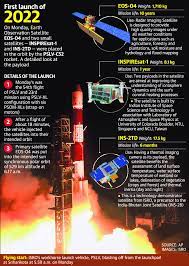17 Feb 2022 Earth Observation Satellite: EOS-04

Today Current Affairs
- Recently the Earth Observation Satellite (EOS-04) of the Indian Space Research Organization and two other small satellites (INSPIREsat-1 and INS-2TD) were successfully placed in the desired orbit by PSLV-C52 rocket.
- It was the 54th flight of the Polar Satellite Launch Vehicle (PSLV) and its 23rd most powerful XL-version with six strap-on boosters.
Earth Observation Satellites- Today Current Affairs
- Earth observation satellites are satellites equipped with remote sensing technology, which collect information about the physical, chemical and biological systems of the Earth.
- Many Earth observation satellites are deployed in sun-synchronous orbit.
- Other earth observation satellites launched by ISRO include RESOURCESAT-2, 2A, CARTOSAT-1, 2, 2A, 2B, RISAT-1 and 2, Oceansat-2, Megha-Tropiques, Saral and SCATSAT-1, INSAT-3DR, 3D included.
Three satellites launched: The Hindu Analysis
EOS-04:
- EOS-04 weighs 1,710 kg and is designed to provide high quality images in all weather conditions with a mission duration of ten years for applications such as agriculture, forestry and plantation, soil moisture and hydrology, and flood mapping has been done.
- It will complement the data from RESOURCESAT, CARTOSAT and RISAT-2B series satellites, which are already in orbit.
- The first satellite in the series of these satellites – EOS-01 was launched in November 2020 and is still in orbit. EOS-02 will be launched on a new launch vehicle named SSLV (Small Satellite Launch Vehicle), while the launch of EOS-03 failed in August, 2021.
- It will be placed in a Sun-synchronous polar orbit of 529 km. It is a radar-imaging satellite, making it a part of the ‘RISAT’ series. Today Current Affairs.
- It will replace RISAT-1, which was launched in the year 2012, but has not been functional since last few years.
- RISAT Synthetic Aperture Radar is used to obtain high-resolution images of the land.
- A major advantage of radar imaging over optical instruments is that it is unaffected by weather, clouds or fog or lack of sunlight.
- It can capture high-quality images in all conditions and at all times, making it perfect for surveillance.
INSPIREsat-1:
- INSPIREsat-1 is part of a group of satellites planned under the International Satellite Program in Research and Education, which includes the Small-Spacecraft Systems and Payload Center (SSPACE), University of Colorado (US), Nanyang the Technological University (NTU) consists of the Small-Spacecraft Systems and Payload Center (SSPACE), Singapore and the National Central University (NCU), Taiwan. The Hindu Analysis.
- INSPIREsat-1 carries two scientific payloads with a mass of 8.1 kg and a one-year mission with the aim of improving the understanding of the dynamics of the ionosphere (part of Earth’s upper atmosphere) and the coronal heating processes of the Sun.
INS-2TD:
- INS-2TD is a technology demonstrator for the first India-Bhutan joint satellite to be launched in March 2022.
- The two countries signed a space agreement last year, under which Bhutansat or INS-2B would be launched by PSLV rocket in March 2022.
- INS-2TD’s thermal imaging cameras are for Earth observation, such as estimating land and water surface temperatures and identifying forest and tree cover.
India’s Space Satellites: The Hindu Analysis
- India currently has 53 operational satellites, of which 21 are earth observation and the other 21 are communication based.
- Eight are navigation satellites, while the remaining three are science satellites.


No Comments